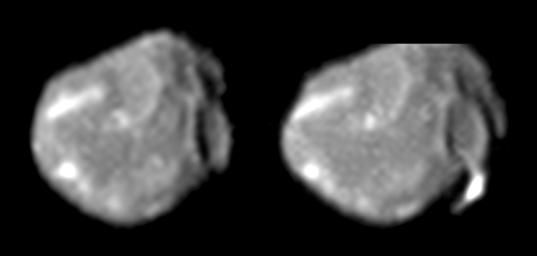These two images of Jupiter's small, irregularly shaped moon Amalthea, obtained by the camera onboard NASA's Galileo spacecraft in August 1999(left) and November 1999 (right), form a "stereo pair" that helps scientists determine this moon's shape and the topography of its surface features. Features as small as 3.8 kilometers (2.4 miles) across can be resolved in these images, making them among the highest-resolution images ever taken of Amalthea.
The large impact crater visible in both images, near the right-hand edge of Amalthea's disk, is about 40 kilometers (about 29 miles) across; two ridges, tall enough to cast shadows, extend from the top of the crater in a V-shape reminiscent of a "rabbit ears" television antenna. To the left of these ridges, in the top center portion of Amalthea's disk, is a second large impact crater similar in size to the first crater. To the left of this second crater is a linear "streak" of relatively bright material about 50 kilometers (31 miles) long. In previous spacecraft images of Amalthea taken from other viewing directions, this bright feature was thought to be a small, round, bright "spot" and was given the name Ida. These new images reveal for the first time that Ida is actually a long, linear "streak." This bright streak may represent material ejected during the formation of the adjacent impact crater, or it may just mark the crest of a local ridge. Other patches of relatively bright material can be seen elsewhere on Amalthea's disk, although none of these other bright spots has Ida's linear shape.
In both images, sunlight is coming from the left and north is approximately up. Note that the north pole of Amalthea is missing in the right-hand image (it was cut off by the edge of the camera frame). The bright streak, Ida, is on the side of the moon that faces permanently away from Jupiter, and the crater near the right-hand edge of the disk is in the center of Amalthea's leading side (the side of the moon that "leads" as Amalthea moves in its orbit around Jupiter).
The images are, from left to right: Amalthea taken on August 12, 1999 at a range of 446,000 kilometers (about 277,000 miles) and on November 26, 1999 at a range of 374,000 kilometers (about 232,000 miles).

 Planetary Data System
Planetary Data System












